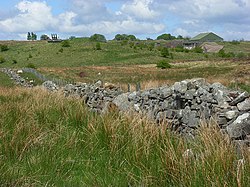RAF Spadeadam
| RAF Spadeadam | |
|---|---|
| Near Gilsland, Northumberland in England | |

RAF Spadeadam
|
|

'Si vis pacem para bellum'" (If you seek peace, prepare for war)
|
|
|
Shown within Cumbria
|
|
| Coordinates | 55°01′30″N 002°36′08″W / 55.02500°N 2.60222°WCoordinates: 55°01′30″N 002°36′08″W / 55.02500°N 2.60222°W |
| Type | Royal Air Force station |
| Area | 7,820 acres (3,165 ha) |
| Site information | |
| Owner | Ministry of Defence |
| Operator | Royal Air Force |
| Site history | |
| Built | 1955 |
| In use | 1957 – present |
| Garrison information | |
| Current commander |
Wing Commander R Henderson-Begg |
RAF Spadeadam (IATA: N/A, ICAO: EGOM) is a Royal Air Force station in Cumbria, England close to the border with Northumberland. It is the home of the 9,000 acre (36 km2) Electronic Warfare Tactics Range, making it the largest (by area) RAF base in the United Kingdom. Its primary use is for Electronic Warfare (EW) training to the Royal Air Force and NATO allies. The site and course of Hadrian's Wall runs a few miles south of the range.
Spadeadam was remote and largely uninhabited until 1955 when the Intermediate Range Ballistic Missile Test Centre was built for the Blue Streak missile project. The RAF took it over in 1976 and it became Europe's first Electronic Warfare Tactics Range in 1977. The range contains ground-based electronics warfare equipment to act as a simulated threat to training aircrews. Some of the equipment was manufactured in the Soviet Union; some simulates emissions from potential enemy systems. It also has real and dummy targets such as airfields, a "village" of portable buildings, tanks, aircraft and vehicle convoys.
The site's role in Britain's Cold War nuclear weapons programme was made public in 2004 when tree-felling uncovered remains of abandoned excavations for a missile silo. A survey of the site by the RAF and English Heritage has attempted to record and interpret what was previously so secret that no plans from the period exist. Spadeadam was chosen as a launch site because of its isolation combined with nearby infrastructure capable of supporting it with such as a plentiful water supply, access to the National Grid and road connections. A stretch of the road to the site from Gilsland had to be bypassed to make access easier for heavy trucks and the abandoned section is still known as "half-shaft" due to its unfortunate effect on vehicle transmissions. Spadeadam was probably intended to be one of 60 launch sites but these were never built and it was only used as a test facility for engine firings and testing electronics and ground installations.
...
Wikipedia

